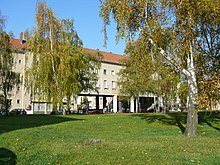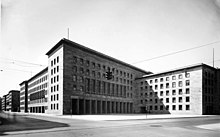Nachtigalplatz (Berlin)
The Nachtigalplatz is a place in the African neighborhood in Berlin district of Wedding . It is the central square of the quarter and the listed Friedrich-Ebert-Siedlung .
Nachtigalplatz is located at the Petersallee / Togostraße junction and is cut diagonally by Afrikanische Straße. The rectangular square is 150 meters long and 110 meters wide.
It is named after the doctor and Africa researcher Gustav Nachtigal . This has led to fierce controversy again and again since the 2000s , since, according to the critics, Nachtigal was one of the driving forces behind German colonialism in Africa. It was therefore decided to name the square after Manga Bell instead .
history
First you can see the later Nachtigalplatz on the overview plan of Berlin from 1900/1901. There it is registered as place Z to be built , but the location differs partially from the current location. Nachtigalplatz got its name as early as 1910 when the streets of the African Quarter were named after the German colonies in Africa, but it was not given its shape until 1938 during the last construction phase of the Friedrich-Ebert-Siedlung.
The square underwent a redesign in 1955. Petersallee and Afrikanische Straße were redesigned into pedestrian areas at this point. At the same time, however, the streets were widened and new parking spaces created, so that the square became quieter on the one hand, but also lost green spaces.
Shape and development
The square is designed by loosely standing groups of birch trees on a lawn, which contrast with the strict development on the edge.
The development of the square is uniform. These are the last buildings of the Friedrich-Ebert-Siedlung, created between 1937 and 1939 by Werner Harting and Wolfgang Werner. In contrast to older parts of the Friedrich-Ebert-Siedlung, these are again built in perimeter blocks , true to the architectural conceptions of National Socialism . There are only gaps where African Street and Petersallee meet the square. The Togostraße, on the other hand, is built over towards the square. This was intended to prevent from being able to see from the square the parts of the Friedrich-Ebert-Siedlung that were behind it and were still built in the Weimar Republic . The design with pillars was based on the Reich Aviation Ministry established in 1935 on Leipziger Strasse.
Naming
Gustav Nachtigal as the namesake is controversial. As Reich Commissioner for West Africa, the "founder of the German colonies in Africa" conquered areas in West Africa with the help of the German army and occupied them by force for Germany. As with other streets and squares in the African Quarter with a similar naming history, this has led to a dispute about the name, how to use it and a possible renaming for decades.
In February 2016, at the suggestion of the residents' initiative “Pro African Quarter” , the CDU Mitte submitted an application to the BVV to rededicate the square. It would keep its name, but would no longer be named after Gustav Nachtigal, but after the theologian Johann Carl Christoph Nachtigal . Something similar had already happened in 1986 with the adjacent Petersallee, which since then has no longer been named after the colonial ruler Carl Peters , but after the resistance fighter Hans Peters . Activists who have been dealing with the history of street names in the African Quarter for a long time, however, accuse the proposal of contributing to the concealment of German history and nothing to deal with it. They are more likely to demand a renaming, for example after an African resistance fighter. In the meantime, the BVV decided to rename the company.
Web links
- Nachtigalplatz. In: Street name lexicon of the Luisenstädtischer Bildungsverein (near Kaupert )
Individual evidence
- ↑ Manfred Götzke: How a street name is disputed in Berlin. In: deutschlandfunkkultur.de. August 7, 2019, accessed August 10, 2019 .
- ↑ a b c d Gerd Kittelmann, Brigitte Prévot: Nachtigalplatz . In: District Office Wedding of Berlin (Ed.): Stadtplatz im Wedding . Berlin 1991, p. 52 .
- ↑ List, map, database. Senate Department for Urban Development and the Environment, accessed on May 24, 2016 .
- ↑ Ulrich Hartung: Function and form principle in National Socialist architecture . In: Bernfried Lichtnau (Hrsg.): Architecture and urban development in the southern Baltic Sea area between 1936 and 1980: Publication of the contributions to the Art History Conference, 8. – 10. February 2001 . Lukas Verlag, 2002, ISBN 978-3-931836-74-0 , pp. 77 .
- ↑ a b Tina Heidborn: One nightingale - or the other? In: rbb-online.de. February 27, 2016, accessed May 24, 2016 .
- ↑ Dirk Jericho: CDU wants to rededicate two street names in the African Quarter. In: berliner-woche.de . February 14, 2016, accessed May 24, 2016 .
- ↑ Re- zoning in the African Quarter from the residents' point of view. In: Weddingweiser. February 17, 2016, accessed May 24, 2016 .
- ↑ Street renaming in the African Quarter in Berlin Mitte , District Office Mitte, Press Release No. 034/2017, February 1, 2017, accessed on February 10, 2017.
- ^ Off for colonialists. In: taz , February 3, 2017, accessed on February 10, 2017.
Coordinates: 52 ° 33 '25 " N , 13 ° 20' 4.3" E


